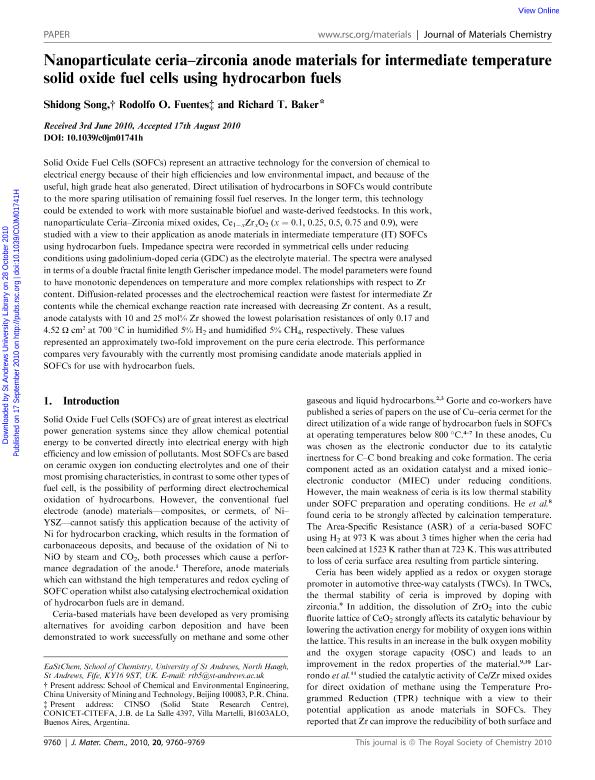Mostrar el registro sencillo del ítem
dc.contributor.author
Song, Shidong
dc.contributor.author
Fuentes, Rodolfo Oscar

dc.contributor.author
Baker, Richard T.
dc.date.available
2023-03-14T12:48:52Z
dc.date.issued
2010-10
dc.identifier.citation
Song, Shidong; Fuentes, Rodolfo Oscar; Baker, Richard T.; Nanoparticulate ceria-zirconia anode materials for intermediate temperature solid oxide fuel cells using hydrocarbon fuels; Royal Society of Chemistry; Journal Of Materials Chemistry; 20; 43; 10-2010; 9760-9769
dc.identifier.issn
0959-9428
dc.identifier.uri
http://hdl.handle.net/11336/190445
dc.description.abstract
Solid Oxide Fuel Cells (SOFCs) represent an attractive technology for the conversion of chemical to electrical energy because of their high efficiencies and low environmental impact, and because of the useful, high grade heat also generated. Direct utilisation of hydrocarbons in SOFCs would contribute to the more sparing utilisation of remaining fossil fuel reserves. In the longer term, this technology could be extended to work with more sustainable biofuel and waste-derived feedstocks. In this work, nanoparticulate Ceria-Zirconia mixed oxides, Ce1-xZrxO2 (x = 0.1, 0.25, 0.5, 0.75 and 0.9), were studied with a view to their application as anode materials in intermediate temperature (IT) SOFCs using hydrocarbon fuels. Impedance spectra were recorded in symmetrical cells under reducing conditions using gadolinium-doped ceria (GDC) as the electrolyte material. The spectra were analysed in terms of a double fractal finite length Gerischer impedance model. The model parameters were found to have monotonic dependences on temperature and more complex relationships with respect to Zr content. Diffusion-related processes and the electrochemical reaction were fastest for intermediate Zr contents while the chemical exchange reaction rate increased with decreasing Zr content. As a result, anode catalysts with 10 and 25 mol% Zr showed the lowest polarisation resistances of only 0.17 and 4.52 Ω cm2 at 700 °C in humidified 5% H2 and humidified 5% CH4, respectively. These values represented an approximately two-fold improvement on the pure ceria electrode. This performance compares very favourably with the currently most promising candidate anode materials applied in SOFCs for use with hydrocarbon fuels.
dc.format
application/pdf
dc.language.iso
eng
dc.publisher
Royal Society of Chemistry

dc.rights
info:eu-repo/semantics/openAccess
dc.rights.uri
https://creativecommons.org/licenses/by-nc-sa/2.5/ar/
dc.subject
Solid oxide fuel cell
dc.subject
anode
dc.subject
ceria-zirconia
dc.subject
direct oxidation of hydrocarbons
dc.subject.classification
Nano-materiales

dc.subject.classification
Nanotecnología

dc.subject.classification
INGENIERÍAS Y TECNOLOGÍAS

dc.title
Nanoparticulate ceria-zirconia anode materials for intermediate temperature solid oxide fuel cells using hydrocarbon fuels
dc.type
info:eu-repo/semantics/article
dc.type
info:ar-repo/semantics/artículo
dc.type
info:eu-repo/semantics/publishedVersion
dc.date.updated
2023-03-12T15:46:46Z
dc.journal.volume
20
dc.journal.number
43
dc.journal.pagination
9760-9769
dc.journal.pais
Reino Unido

dc.journal.ciudad
Cambridge
dc.description.fil
Fil: Song, Shidong. University of St. Andrews; Reino Unido
dc.description.fil
Fil: Fuentes, Rodolfo Oscar. Consejo Nacional de Investigaciones Científicas y Técnicas; Argentina
dc.description.fil
Fil: Baker, Richard T.. University of St. Andrews; Reino Unido
dc.journal.title
Journal Of Materials Chemistry

dc.relation.alternativeid
info:eu-repo/semantics/altIdentifier/url/https://pubs.rsc.org/en/content/articlelanding/2010/jm/c0jm01741h
dc.relation.alternativeid
info:eu-repo/semantics/altIdentifier/doi/http://dx.doi.org/10.1039/C0JM01741H
Archivos asociados
